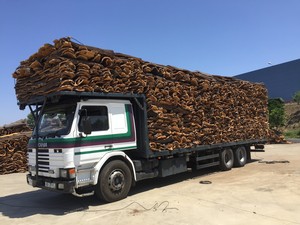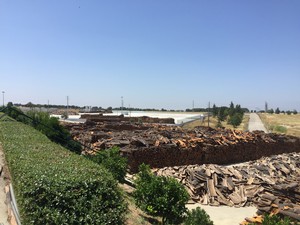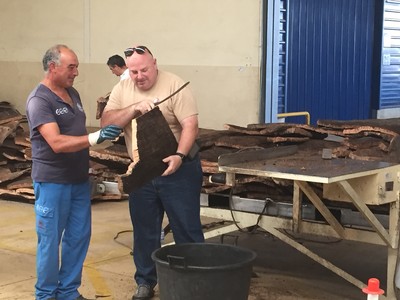Cork Resting and Processing - Part 5 in Winemaker Andy Schweigers' Portugal Journey


After it has been determined that the cork is ready to be moved on, the cork is stacked onto large stainless steel racks. The racks are then lowered into a steamer. Chlorine free water is brought to a boil and these slabs “cook” under pressure and steam for about twenty minutes. When it is done, the cork is much more sanitary and has flattened out substantially, making it much easier to handle. The steamers are powered by burning cork pieces that are recovered later in the processing. From here, the slabs are brought inside for some preliminary sorting.
Next to the steam vats is a large warehouse, almost the size of a Costco. In here are about twenty sorting stations. At each one, a man with a very strong dominant arm holds court. Piece by piece, he removes a freshly steamed slab from the pile and cuts a thin slice off of two sides from each piece with a long, thin scythe like knife. In that instant, he evaluates the porosity of the cork and sorts it in to one of several different piles based upon grade. Now, I’ve always been a hands on kind of guy…so in my broken Portuguese, I asked one of the men if I could try, he smiled and handed the knife over. Anxious to try a new opportunity, yet also not wanting to hospitalize myself, I gave a tentative pull. It was a lot harder than it looked. My new friend smiled, adjusted my stance and how I was pulling. It became EVER so slightly easier.
Now, I’ve always been a hands on kind of guy…so in my broken Portuguese, I asked one of the men if I could try, he smiled and handed the knife over. Anxious to try a new opportunity, yet also not wanting to hospitalize myself, I gave a tentative pull. It was a lot harder than it looked. My new friend smiled, adjusted my stance and how I was pulling. It became EVER so slightly easier.
As the sorted piles grow, they get palletized, labeled, and loaded on to trucks…from here, it’s a three hour drive north to Porto which it was time for our busload of winemakers to do as well.
There are two important things that happen in this sort. First of all, they are getting a pre-sort on the quality of the bark. Secondly, there is now a very smooth surface on two sides of the cork…but that wouldn’t become evident until the next day, when we got to see the cork being punched…
